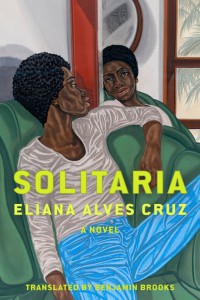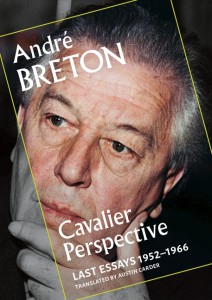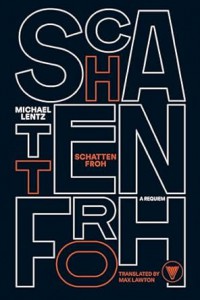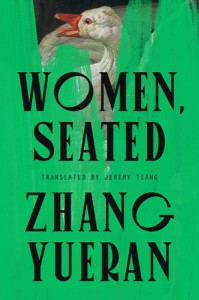This month’s round-up of newly released titles spans twelve titles across twelve countries. We’ve got a profound and lucid collection compiled of diaries from the genocide in Gaza; a readdressing of womanly sacrifice in the domestic realm; an Argentinian novel reinventing the history of Italy’s famed “Park of the Monsters”; the long-awaited esoteric and experimental tome from German writer Michael Lentz; essays and textual riches from the father of surrealism; and much, much more. . .

Voices of Resistance: Diaries of Genocide by Nahil Mohana, Sondos Sabra, Ala’a Obaid, and Batool Abu Akleen, translated from the Arabic by Basma Ghalayini and Ayah Najadat, Comma Press, 2025
Review by Justin Goodman
Similar to the intimate testimonies of Atef Abu Said’s Don’t Look Left and Plestia Alaqad’s The Eyes of Gaza, Voices of Resistance compiles the diaries of four Gazan women, tracing their thoughts as they mourn their martyred, fear their decimation, celebrate the Palestinian people, and sacrifice meals for the sake of birthday pastries. Together, Batool Abu Akleen, Sondos Sabra, Nahil Mohana, and Ala’a Obaid highlight what Gillian Slovo describes in her introduction as both a beauty “in [their] honesty and spirit” and a horror as they gain “a whole new vocabulary for describing the sounds of different bombs.” This latter is compiled by Mohana in a list running half a page long, as she distinguishes the subtleties between “Bouf” (aerial bombing) and “Dddof” (artillery shelling). Most importantly, however, she adds: “. . . we have begun to lose our hearing.”
The collection begins with Batool Abu Akleen’s anxiety over an exam and “a fear of living life.” A poet whose debut collection, 48kg., was published in June, her defiantly alive tone is apparent from the outset. She describes a type of bread called ghorayeba, which she loves, before comparing herself to it—since “my toughness melts when I notice the buzzing of Israeli drones over our heads.” In her unsparing honesty, one is also reminded that a journal is a place that preserves our most horrible thoughts:
. . . I wish for the disappearance of this homeland itself—a place that confuses the entire world—so that all of us can go to a place where there is no fatigue or hardship; so that not another human being will be born in a place as sad as this.
Shifting from this unsustainable, inescapable intensity to a sense of remembrance, writer and translator Sondo Sabra describes fleeing her orchard—established by her grandfather eighty years prior—with her family, a dismemberment of body and land through which “Israel tried to wring death out of every last second. This is not a metaphor but a fact.” Another fact is a heavy joke that she later overhears between two friends: “The good people die, and those like you live!”
While Sabra will later risk death to return to Gaza, the novelist and playwright Nahil Mohana risks death to stay. Harrowingly, many of her entries begins with: “Thank God that we are still alive.” In a maternal “we,” she recounts details like stray animals “growing fat” on corpses, and makes prolific use of bomb vocabulary. Following this, the mother and writer Ala’a Obaid recounts her brother’s forty-nine day detainment and torture, but assures him (and us): “Dearest Mohammad, your story isn’t over yet.”
So such stories continue, as from immortal terror will also spring the impossible triumph of maintaining one’s humanity. One can only hope that as long as these powerful voices continue to speak to us, we—and anyone with the power to stop this ongoing genocide—will repay them with our listening.

Solitaria by Eliana Alvez Cruz, translated from the Portuguese by Benjamin Brooks, Astra House, 2025
Review by Mathilde Hjertholm Nielsen
In Ousmane Sembène’s seminal film Black Girl (1966), Diouana, a domestic servant from Dakar, finds herself trapped within the starkly pristine confines of her employer’s French apartment. Literally and figuratively imprisoned in the dizzying white space, she eventually takes her own life. Solitaria, the fourth novel by Afro-Brazilian writer and journalist Eliana Alves Cruz, likewise deals with the claustrophobia of domestic servitude. “I realized once again that for those who weren’t residents, everything was little: littleroom, little-apartment, little-bathroom. . .” reflects Mabel, our primary narrator, whose mother works as a live-in maid to a couple in a luxury apartment building called the Golden Plate. In the vein of Sembéne’s film, Solitaria charts the architecture of racialized class dynamics within an urban geography. If Black Girl probes the contours of severe isolation, Solitaria explores the complex webs of proximity that characterize the relationships between residents of the Golden Plate.
Those who inhabit but don’t entirely live in the Golden Plate are those that know it best: Mabel and her mother Eunice, doorman Jurandir and his two sons, the studious Cacau and the turbulent João. The status of these lesser inhabits is manifested spatially by their physical positions within the building, yet the possibility of a brighter future nevertheless carves out its own spaces. Mabel likens her childhood to a “waiting room of preadolescence,” while Jurandir refers glowingly to Cacau’s acceptance into a prestigious secondary school as a “window of opportunity” to the future. Even a littleroom has exits.
Solitaria bares the illusion of invisibility that undergirds the relations of domestic labor: “Besides the tight spaces we occupied, it was the silence that kept us company. We needed to be present without being.” In this, Alves Cruz’s novel is a testament to the impossibility of inhabiting without living, or of presence without being. As though to emphasize this, the novel is bookended by two parallel incidents in which the actions of servants prove decisive—the first in saving the life of a child, the second in bringing justice after an act of negligence leaves another child dead.
The architecture of the Golden Plate penthouse is physically implicated in both accidents and reflects Alves Cruz’ preoccupation with the bounds of agential animacy. In the novel’s final section—called solitárias, the plural form of the novel’s title—various rooms from the Golden Plate take over narration in the first person. The rooms are positioned as repositories of intimacy, witnesses to the interiority of the characters’ lives: “How many times had I seen Jurandir awake, worried about João’s future, distressed over him getting into trouble. . .” muses the Doorman’s room. This anthropomorphic turn produces a choral effect, transforming otherwise private moments into a network of shared expression. By lending a narrative agency to the building’s architecture, Alves Cruz likewise restores agency to the human subject within those spaces. Thus, architecture is refigured from a symbol of systemic disempowerment to embody the possibility of collective experience.

The Book of Homes by Andrea Bajani, translated from the Italian by Elizabeth Harris, Deep Vellum, 2025
Review by Mathilde Hjertholm Nielsen
Reading The Book of Homes by Andrea Bajani, I learnt the word proxemics: a “branch of knowledge that deals with the amount of space that people feel it necessary to set between themselves and others.” Bajani’s novel itself is a study in proxemics, charting a man’s life and his relationships through a series of homes he inhabits across four decades.
Proxemics is always an exercise in syllepsis; the space we create between ourselves and others is inherently a dialogue between the figurative and the literal. The titular homes in The Book of Homes are likewise suspended between metaphor and reality. Some, like “Home Beneath the Mountain,” are concretely material, while others, like “Home of Escaped Memories,” are acutely metaphysical. (The “Home of Escaped Memories” may be Bajani’s most ingenious piece of architecture, imagined as a claw machine in which misplaced memories lay buried under layers of shifting sand.)
Our main character is known only to the reader as “I,” though he does not narrate the story, which is told from the perspective of a sort of ambient omniscience, a presence peeking through the windows. I functions more as a stand-in for the exemplarity that narrative demands than as a character, a “seam-side” out exposition of subject formation. This scale of narration allows Bajani to deftly imbricate the personal and the general, always positioning I within a larger architecture of collective alienation. Take the second-hand furniture warehouse wherein I discards his belongings after his divorce, which Bajani describes as “the mass grave of the Millenium. . . . A place where the present replenishes itself for its collages, its mosaics of consigned, dusty, twentieth-century shards.”
The Book of Homes, ultimately, surveys a landscape of manmade systems. Banjani imagines bureaucracy, civil society, capital, and the nuclear family as forms of architecture—as homes we make in the world; the identity of the State is “composed of concrete,” and I’s engagement ring to his former wife is known as their “Forever Home.” It is a minimalist systems novel, if you will, in which Banjani attends to the comfort and banality we seek in the systems that shape our lives.

Cavalier Perspective: Last Essays 1952-1966 by André Breton, translated from the French by Austin Carder, City Lights Books, 2025
Review by Eric Bies
Cavalier Perspective ranges over the final phase of André Breton’s career; more than just essays, the book collects assorted reportage, interviews, survey responses, and letters—including a number of forewords and prefaces written for other writers’ books, offering a balanced portrait of the man who founded and sustained one of the twentieth century’s most influential arts movements.
That would be Surrealism, of course, which turned a hundred last October. While Guillaume Apollinaire gets credit for coining the term, Breton was the one to define the Surrealist position in a manifesto, a position that this book continuously clarifies. As Garrett Caples writes in his introduction, “Far from being an aesthetic or a product, Surrealism was a search for the truth about how to live. It still is.” For Breton, that search prioritized the sensible over the intelligible, “the sovereign light of illumination” over “the precarious glimmer of elucidation,” and necessitated, above all, the abandonment of classical Western values such as reason and logic.
And yet Cavalier Perspective offers just that—page after page of orderly, cogent prose. As for subject matter, Breton was a great admirer of his peers and predecessors, and the book spares no space in promoting them, from Novalis the magician to de Chirico the seer and Rimbaud the minor god. His preface to the 1954 reissue of Charles Maturin’s exceptionally strange gothic novel from 1820, Melmoth the Wanderer, makes for the collection’s finest literary essay—but there’s something for everyone here, including pieces on astrology, conscientious objection, modern art, party games, Druidry, and even the language of stones, which “continue to speak to those with ears to hear them.” That said, certain pieces will seem reserved for only the most dedicated students of Surrealism, such as essays on figures like Robert Amadou and Philip de la Villetheart (who?).
Politically, Breton was always some stripe of Marxist. Here, he writes in opposition to the war in Algeria. There, he quotes passionately from Trotsky’s Diary in Exile. But above all he was a clear-minded heterodox, and if his political writings are aging well, it’s due to his moral clarity, as when he finds reason to compare Stalin to Dostoevsky’s Grand Inquisitor. In opposition to such odious apologists as Sartre (who attempted to justify the gulags), Breton was firmly opposed to authoritarianism—and no wonder; Surrealism’s fundamental concern has always been the freedom to think, speak, and write what has never been thought, spoken, or written before.

The Heart Is Not a Creator by Yordan Efftimov, translated from the Bulgarian by Jonathan Dunne, Broken Sleep Books, 2025
Review by Justin Goodman
There are two Yordan Efftimovs. One is wry and absurd, seeing in a pile of washed-up stones either a heart or “. . . a fist with a thumb sticking out / between the forefinger and the middle finger”—the ocean flipping the bird. The other Efftimov, ruminating on foam sloughed from the ebb, is the reluctant, grieving romantic: “happiness is merely / a pause / in the chain of pain and pressure / people cause each other.” And much like the tides that reach for and recede from humanity throughout this award-winning 2013 collection, the duality of its writer works in The Heart Is Not a Creator to both elongate and shorten the lines, the moods—and even the heart.
Translator Jonathan Dunne has previously translated some of the poems herein (including two of the half-dozen titular poems) for the Bulgarian poetry anthology At The End of the World, and fittingly, this revisiting isn’t just central to the structure of the collection and its translation history, but creates a certain gloom of estrangement hanging over the poems. No matter his subject, Efftimov alienates familiar sights to create new vulnerabilities. When watching two children playing on the beach: “He has stolen the face / and wrinkles of Willie Nelson; / she, of Pippi Longstocking.” When catching someone losing focus on what’s in front of them: “The next moment / some prick . . . / crashes into the back end of your car.” When recounting to his lover how he “imitate[d] various winds” (“a hurricane hot Kazakh ibe,” “an Arabian simoom,” “a Sinai sharab,” and so on), he recalls that “all I got was a laugh.” There is nothing made so familiar by repetition that they cannot evoke pain with a crash, a laugh, or a stolen face. In his vulnerability and anxious self-contradiction, the poet reproduces chuckle-inducing terrors.
This is the peak of Efftimov, though at times it can feel as if the poet is more playful than his translator. Take “Instructions,” in which the voice fears that “. . . once undressed, / we will be afraid to admit how cold we are, / and the joy that the other is also afraid.” The following intrusive thought is translated by Dunne as: “Will we attract strikes of lightning?” It reads as distractingly formal next to Katerina Stoykova-Klemer’s 2014 rendition of the same line: “Will we attract lightning?” What Stoykova-Klemer understands is that Efftimov’s poems are banter, and good banter is direct.
But these are mere air pockets (or “air pits,” as Dunne curiously translates in another poem) in an otherwise solid translation of this dark comedy—where “there is no difference between the tide and the eruption of a volcano or the sun,” and where the tides flip you off.

True Colors: Growing Up Weird in the 90s by Elise Gravel, translated from the French by Montana Kane, Drawn & Quarterly, 2025
Review by Justin Goodman
Elise Gravel’s work, from Disgusting Critters to Olga, is for the outcasts. Exuberant and occasionally frenetic, she delights in ugly cuteness and attends to the wounded defensiveness of sensitive, estranged children, all in the spirit of expanding who is considered “normal.” And while that mission is one thing distinguishing her from fellow Quebecois author-illustrators such as Melanie Watt and Marie-Louise Gay, it is her extraordinary presence in her writing that truly sets her apart. Now, in the memoiristic graphic novel titled after the Cyndi Lauper classic “True Colors,” fittingly subtitled with Growing Up Weird in the 90s, Gravel pushes “normal” to include the “weird.”
Beginning exactly September 28, 1991, the first word of the text that catches one’s eye—as it is rendered bubblegum and ballooning—is: “possible?” Puberty-age Elise is wondering whether the hair growing on her elbow is a sign that she’s becoming a werewolf, and from there, the graphic novel—framed as a diary—unfolds as an airy dark night of the soul. Why is my body changing? What do people mean by love? “Why do farts smell worse when you fart in the bathtub?” In this, True Colors is a gothic comedy to a child experiencing the body horror of puberty and society, and a nostalgic gesture to the well-acquainted adult. The line between these two readers, however, is thin to Gravel, who had laughingly admitted to the CBC: “I’m a child myself.” After all, not even an adult would necessarily know that warmth, nudity, and the slower diffusion of sulfur makes farts worse in the bath.
And true to this textual colorfulness, True Colors is colorful. Not just in its random trivia (Napoleon fought rabbits and lost) and endearing episodes (Elise yawns in class to determine if she’s being watched, only to cause a “yawn-a-thon”), but its design. Occasionally you’ll find a page jumbled in a way Elise herself describes as “weird or gross or quirky,” heightened by that era’s yellow, pink, and blue color schemes. A cartoon New Wave embodying Lisa Frank, April Greiman, Uglydoll, and Saved by the Bell—it’s an inviting style because it’s a simple one, enhanced by loudness. “It doesn’t have to look really good,” Gravel said in an interview for her book Pink, Blue, & You, “the idea is what matters.” That was the lurid aesthetic motto of the era, and that too is Elise Gravel’s mission statement: be loud, be garish—just be yourself.

whitewards by Katarína Kucbelová, translated from the Slovak by Julia and Peter Sherwood, Seagull Books, 2025
Review by Eric Bies
Slovak poet Katarína Kucbelová’s latest book to appear in English is the lyrical-narrative poem-sequence whitewards, set in a world of pale skies, vast snowdrifts, and a winter that shows no sign of ending. It opens with the stark image of “three figures climbing / a white mountainside”; the facts of who they are and where they’re going are never precisely defined. The characters have no names. They chart a fantastic terrain. Their crises—survival and the search for meaning—are as old as Gilgamesh, and no wonder; Kucbelová is a poet who challenges conventional understanding, not through experimentation of the type that has made so much of our contemporary poetry impenetrable, but by dealing in the time-honored crafts of myth and paradox.
Like legendary figures, the climbers climb toward a goal—definite or indefinite, a place of rest and reward. . . or do they? Onwards, upwards, whitewards, Kucbelová’s images spring from the paradoxical notion of motion in winter, when matter’s molecules sit at their stillest. Like Sisyphus rolling his boulder uphill to infinity, these “three figures” aspire absurdly—then, suddenly, they’re “. . . lying in the snow / we don’t know for how long / perhaps it isn’t snow.” And like the thoughts one thinks while scaling a slope forever, some of the poems also step away from the path to consider, philosophize about, and reflect upon whiteness—as when Kucbelová supplies a simple algorithm for achieving “. . . a dazzling whiteness / the whitest white” of white lead paint: “we will warm up slabs of lead with horsedung / sprinkle them with vinegar / and in the steam a white flower will blossom / ceruse.”
Other poems swerve to encompass chants (“may you find success / may you find peace / may you find love / may you find joy”), Steinian repetition (“people used to say / as always / now, instead of as always, they say / as it used to be”), and lots and lots of questions: “is it good news or bad?”—“will the radiance drown the good? / will the darkness engulf the bad?”—“is it revelation or clarification? / a deluge of radiance or order?”
Somewhere in this existential haze hovers a critique of manmade climate change, but Kucbelová’s footwork is so subtle and her approach so sidelong, that the poetry prizes poetics first and politics second. Her poems offer no solutions, just a vision of a possible future—a myth to consider as we slide toward that possible future.

Schattenfroh by Michael Lentz, translated from the German by Max Lawton, Deep Vellum, 2025
Review by Eric Bies
Schattenfroh is German author Michael Lentz’s summa, his summit, his Magic Mountain. It’s also, incidentally, his English debut, one that looks back at the shelf of toweringly literary English-language novels that preceded it—big, fat, brainy ones like Ulysses, The Recognitions, and Gravity’s Rainbow.
In other words, Schattenfroh isn’t just staggeringly long; it’s also hyper-stylized, densely allusive, and structurally complex—a seemingly endless sequence of scenes, set pieces, and stories-within-stories. It’s a demanding book. A single, vertiginous glance will disclose the trademark text-blocks of Sebald and Bernhard, without a chapter break in sight. The book is studded, instead, with other kinds of interruptions: diagrams, typographical shifts, simulated moth damage, metafictional references to pagination, excursions into King James English, even Tristram Shandy’s black page. The occasional image supplies ballast for the book’s chronic ekphrastic tilt (toward a bevy of canvases, clocks, and cathedrals), but Lenz mostly lets language lead the show.
Not merely a patchwork of styles and experiments, the book also assimilates multiple domains of specialized knowledge, much of it mystical in nature, with Western esoterism offering one of the richest veins for future exegetes of this truly encyclopedic novel. Yet for all its range there’s something persistently curtailed about the book as well, which, with its single point-of-view, frequently assumes the exacting contours and burnished interiority of a Beckett novel (Malone Dies gets its own explicit reference about halfway through). Just as Beckett might have done it, the book’s narrator, Nobody, proceeds with blinders on—more or less literally: “writing a printed book in unmediated fashion,” he sits in a darkroom “wearing a facemask and some kind of spectacles,” which are set to explode if removed.
Directed by an irresistible figure named Schattenfroh (“a German family name that means something like ‘shadowglad’”), Nobody’s task is, apparently, to record every thought that crosses his mind. When he isn’t down one of his many rabbit holes (on cartography, the crucifixion, the number 666), much of what ensues reads a lot like Kafka—neurotically, deliciously—gravitating as it does toward a larger-than-life Father figure (Nobody’s), whose outsize presence patterns the novel’s complicated relationships to authority and authorship.
Make no mistake: this is a novel for fans of difficulty—serious difficulty. For that reason, it’s also the kind of novel that rarely gets published. Its appearance in any language is a privilege for daring readers, and Max Lawton’s marvelous translation goes a long way toward establishing Schattenfroh not only as a contender for the attention of active minds but as a monument of world literature.

False War by Carlos Manuel Álvarez, translated from the Spanish by Natasha Wimmer, Fitzcarraldo Editions, 2025
Review by Xiao Yue Shan
According to the Bulgarian writer Georgi Gospodinov: “A truly brave book, a brave and inconsolable book, would be one in which all stories, the happened and the unhappened, float around us in the primordial chaos, shouting and whispering, begging and sniggering, meeting and passing one another by in the darkness.” Reading Carlos Manuel Álvarez’s False War, I thought that the Cuban writer had miraculously come close to Gospodinov’s utopic project—that he had listened sufficiently to the whirlwind, had been sensitive enough to measure the depth of even the most incidental encounters, had turned his head to notice what would’ve been otherwise hopelessly invisibilized, had somehow organized the firm chronology of narrative so that it laid less like a roadmap and more like layers and layers of tulle, in which each moment gave a glimpsing glimmer of other moments, in which many moments are folding and moving together.
False War is one of those novels that a young writer has to create, at some point, if they are attuned enough to the strange, almost impossible nature of their craft—which is to say, it is a work that is concerned with its own creation, is at once suspicious and trusting of its methodologies, and is very clearly enamored with language and the extent to which it can be pushed. Compiled of a series of interlocking and individualized vignettes that render a sprawling mosaic of exile, refugee life, peripeteia, and “immigrant time,” Manuel Álvarez has used the material of a body in motion to capture the immaterial quality of a physicality and psyche at odds. This discrepancy is the fact of migrancy, no matter its circumstances, and it is rich with narrative possibility. Departing the context of one’s homeland is to upend the human elements that are most often taken for granted: the facts of language, culture, family, nationality, and residence. The resulting living experience is hallucinogenic, by turns lucid and hypnagogic; you feel yourself blurring at the edges.
Definitively post-Castro, what False War reckons with most of all is hopelessness, which for most of the world is the impetus to leave home behind—yet even the possibility of leaving eradicates the perceived totality of hopelessness, which must always finally make room for possibility. Through all of its locales, characters, events, and pursuits, Manuel Àlvarez’s characters are veering between despair and possibility, finding themselves despairing while inside possibility, finding themselves probing possibility while enveloped in despair. The text, and its translation by Natasha Wimmer is almost unbearably beautiful at times, drawing further attention to how displacement allows for more surprising, illuminating descriptions: “Our words were like wild animals and you couldn’t tell whether they were fighting or fucking.”
But within this constant shiftiness and restlessness, there is always a singular, biological anchor. In one of the prose’s most powerful moments, an exile returns to Havana and finds himself at a party, and dance—that most intuitive, emotional, and honest of movements—is used as a mechanism by which to articulate the ways that a body finds to trust the world, and how this kineticism certifies one’s fragility, but is also the definition of being alive: “A thread of voltage coordinates extremities and joints, dynamiting and rebuilding the thing created by the very intensity that causes it to fly irremediably apart.” No matter how fractured you feel, no matter if you’re standing in the Louvre while your mind is in Havana, no matter if you’re stuck in Havana and dreaming of Berlin—your body is whole. Your body moves, it holds you, and it is whole. False War is written with this same sense of containing the uncontainable, for perhaps the only space beyond the human body that can bear so many fractures is the book, which exists to cohere—even if just temporarily—the infinite fragments of our indeterminate, unsettled reality. Brave, inconsolable book.

Bomarzo by Manuel Mujica Lainez, translated from the Spanish by Gregory Rabassa, New York Review Books, 2025
Review by Justin Goodman
Before Bomarzo, the first and only Manuel Mujica Lainez novel to appear in English was The Wandering Unicorn in 1985, a historically-grounded folkloric narrative that was perhaps appropriate to the then rise of magical realism. Now that publishers have returned to Mujica Lainez, one finds that Bomarzo, originally published in 1962, is likewise a good fit for our bitter era of sinister and desperate occultism. Translated by Gregory Rabassa (whose previous work includes Gabriel García Márquez’s One Hundred Years of Solitude), Bomarzo continues its translator’s perennial good taste while adding another steeple to what Jorge Luis Borges, in his foreword to The Wandering Unicorn, called ”the true history” of Latin American literature.
If, as Álvaro Enrigue observes in his introduction to Bomarzo, Mujica Lainez’s notes on the novel’s “final architecture” sound “more like a cathedral than like a novel,” this cathedral is built around the real-life sixteenth-century duke, Pier Francesco Orsini—duke of the Italian city Bomarzo and posthumously famous for his garden of monstrous sculptures. In turning away from facticity, Mujica Lainez’s text is as languorous as tar, with a potently psychosocial Orsini written as the archetypal Frankenstein’s creature: a hunchback. Raised by an abusive father who has the “refined imagination and atrocity of a Renaissance man,” Orsini becomes an ambivalent—but mostly merciless—duke capable of precisely the same imaginative cruelty. Even Mujica Lainez’s imagery is the same in this regard: Orsini’s wife’s legs “shone like swords,” while a hunted Lorenzino de’ Medici is depicted as “a desperate wanderer who saw daggers and more daggers everywhere, as if the shadows of a giant hedgehog were being projected on the wall.”
Central to all the beauteous intrigue and violence are the twin immortalities Orsini must preserve: the family’s mythical Etruscan heritage, and his own horoscope-promised eternal life. The anxiety and terror of this resolve is embodied in a single image—a skeleton in “faded ribbons that . . . had changed it into an obscene parody.” But it is only in narrative hindsight that Orsini understands its mockery, long after he accepts “my father’s history, my grandfather’s history, and the history of my family was nothing but a gloomy tapestry woven out of famous or miserable deaths.” The pith of this mortality-obsessed era is melodrama and sonorous shrapnel—it’s ripe material for an opera, as Alberto Ginastera already proved with his 1968 adaptation.
In clashing against our romanticized image of the Renaissance as a time of scientific, historical, religious, and spiritual revelations, Bomarzo ungilds it, leaving us with a pyrite time of plenty built on sanctimony, privilege, and a timely inability to meet the times—which is to say: it sounds terribly familiar.

The Man Who Died Seven Times by Yasuhiko Nishizawa, translated from the Japanese by Jesse Kirkwood, Pushkin Press, 2025
Review by Mathilde Hjertholm Nielsen
In Yasuhiko Nishizawa’s The Man Who Died Seven Times, one finds a whodunit in the vein of a game of Whac-A-Mole. Our narrator, sixteen-year-old Hisataro, suffers from a Groundhog Day–like condition that, once triggered, causes a day to repeat exactly nine times. This comes in handy when Hisataro’s grandfather is found murdered following a raucous New Year’s Eve celebration, giving Hisataro nine chances to prevent the crime.
While the premise of the time loop takes some heavy expositional lifting to elucidate, the ground rules are intuitive enough to understand once established. Hisataro decides to narrow in on one suspect each day, keeping them away from his grandfather in the hopes that if the older man survives the night, he’ll have successfully identified the killer. But as the title suggests, this method yields mixed results. An acrimonious family dispute over inheritance has made everyone a prime suspect, and the mechanism of the time loop has a funny way of adhering to the original set of events in roundabout ways. As soon as Hisataro manages to eliminate one murderer, another one pops up—Whac-A-Mole-style—to take their place.
Another analogy comes to mind: the board game Mastermind, in which the player is a codebreaker trying to guess the correct order and color of four little pegs within an allotted number of turns. After each attempt to crack the code, possible combinations are narrowed down through trial and error. Not only is Hisataro trying to unravel the code of his grandfather’s murder before his turns run out, but his grandfather manipulates their family members like pawns—assigning each relative a brightly colored tracksuit and forcing them to compete for their inheritance.
In its intricacy, The Man Who Died Seven Times can be difficult to follow, especially in its latter half. There are some the twists and turns that would make even Benoit Blanc’s dapper head spin. And yet the novel is buoyed by an earnestness that takes such irreverent delight in its own puzzles that it’s ultimately impossible not to do the same. You can’t help but play along, whether or not you’re into game theory.

Women, Seated by Zhang Yueran, translated from the Chinese by Jeremy Tiang, Riverhead Books, 2025
Review by Xiao Yue Shan
Last year, the number one foreign novel on Douban—China’s top platform for book, film, and music ratings—was Elena Ferrante’s The Lost Daughter. In the reviews, readers lauded Ferrante’s unrestrained portrait of womanly despair, sharing their own opinions on the self-negating model of motherhood within patriarchal systems, in which sacrifice ferments into resentment, familial bonds transform into constraints, and a life counts up as a series of losses. One highly rated comment simply stated: “Motherhood is the opposite of self-actualization.”
Recently, the traditionally noble concept of sacrifice, particularly within the domestic sphere, has been put on trial in China, with multiple viral articles adopting the term “60% mother” to advocate for self-preservation and appropriate distance, drawing attention to the absurdity and violence of the “perfect” parent. It’s not a new conversation, but sacrifice will always be a point of contention when it comes to China and its familial infrastructure; it’s embedded into the generational cycle as a necessary exchange for excellence, with the perception that achievement is never sourced to the individual, but also to everything and everyone who enabled that individual in the world—which is to say that sacrifice is not only a pure device borne of love, but also an idealism of delayed gratification.
Zhang Yueran’s award-winning novel, Women, Seated, is one of the many contemporary Chinese fictions that interrogates this value exchange of sacrifice, emerging out of its author’s own experiences of motherhood and its brutal clarities. At the center of the narrative is Yu Ling, the nanny to an extremely wealthy family, and the sequence of devotions that make up her existence. She’s unquestionably bonded to her charge, the young Kuan Kuan, although he is only the latest in a series of her loyalties—most of them one-sided. This attachment, however, is tested when the patriarch of the family becomes subject to criminal investigation, and Yu Ling finds herself suddenly left alone with the child in the palatial estate.
The novel is disinterested in the titillating themes of political power-play and downfalls of the mighty. In an interview, Zhang had stated that the plot allows for a disappearance of the men, enabling new conditions within which the women of the story can re-evaluate both their own existence and that of the women around them. Women, Seated thus moves not through action, mission, or even conflict—but through the staggered arrival of new female characters, disturbing and recalibrating the assumptions and standards of their roles and responsibilities. Within their positions are multiple incarnations of sacrifice—different applications, different values, different approaches to what has long been seen as an inherent quality of Chinese womanhood. Therein lies Zhang’s delicate, careful ethos: it is easy to judge someone’s choices, but once you know what they have sacrificed or what they are willing to sacrifice, it is even easier to understand them.
Chinese communality means that solidarity is still the essential base by which to regard social phenomena. Personhood, in this dense and collective civilization, is defined more so by recognition than it is by the western proposition of rights—this complicates the tragedy of sacrifice, and it also creates a space in which its worth and depth are constantly reassessed and renegotiated. Women, Seated emerges in this dispute, wherein the domestic is attempting to calibrate to our contemporary, precarious, insecure, metastasizing moment, and we are witnessing, if not a changing of the guards, then an attempt to shuffle the formations. It is telling that Yu Ling, despite all that she has forfeited, is left with no regrets. In the book’s final pages, she is given a tiny, almost devastating moment of heroism. Turns out what matters is not what has been sacrificed, but how we are transformed by our most selfless acts.
Eric Bies is a high school English teacher. His writing has appeared in World Literature Today, Rain Taxi, Full Stop, Open Letters Review, and many other places. He lives in Southern California.
Justin D. Goodman (they/them) is a writer based in Brooklyn, NY and a member of the New Haven Writers’ Group. Their work has been published in Cordite Review, Baby Teeth, and Prairie Schooner.
Mathilde Hjertholm Nielsen is a first-year Literature Phd student at Duke University interested in the intersection of theology, temporality, and media studies. She is originally from Copenhagen, Denmark.
Xiao Yue Shan is a poet, writer, editor, and translator.
*****
Read more on the Asymptote blog:

